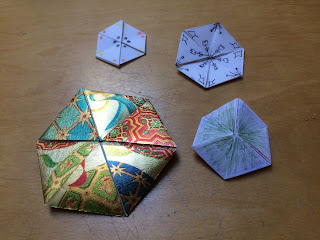In The Breakfast Club, Molly Ringwald’s character, Claire, is asked what she can
do. All the other kids in detention have started making claims about what they
can do—one says she can write with her feet, another that he can make spaghetti.
Claire says she can’t do anything, and someone replies that everybody can do something. So she reluctantly—but still with some
pride—demonstrates her ability to apply lipstick (messily) without using her
hands.
We should all have some sort of trick
that we can show off on such occasions. Some people have actual magic tricks—you
may have run into someone who can pull a quarter from your ear, then make the
coin disappear and reappear again elsewhere. That’s impressive. It’s
especially good for astounding visiting children.
Other people can casually take up three
clementines and start juggling them. I’ve noticed that people are impressed by
even a very limited ability to juggle (unless they themselves can juggle, of
course.) Juggling is also contagious—once someone juggles something, everyone
starts trying to juggle. This can be dangerous if the objects used are
breakable or messy, but clementines are pretty sturdy.
There are people who can square off
discarded candy wrappers and fold them into beautiful cranes. Instead of a
piece of trash, you have a decoration. Part of what makes it special, though,
is watching the transformation.
Being able to play an instrument can be
a party trick when the instrument is there in your pocket. My father-in-law is
known for pulling out his harmonica on any occasion and playing a suitable
tune.
Not all party tricks require props. My
husband can pretend to inflate his hand. He blows “into” the thumb, the hand slowly
opens up, he pinches the thumb “closed”—then he lets go and his hand goes
hissing and spinning crazily about as it “deflates”. I’ve seen it many times
and I’m still amused.
Reciting a poem is, or should be, a
party trick as well. I think the most effective poems for this purpose are
those that tell a story, such as “The Raven” by Edgar Allen Poe, or “The Highwayman” by Alfred Noyes. So I recommend memorizing one long poem to have on
hand when you need it. I started memorizing “The Raven,” but didn’t get
beyond the first couple of stanzas. I also only know about half of “The Singsong of Old Man Kangaroo” by Rudyard Kipling (perhaps not technically a
poem, but it recites like one.) I still remember parts of “The Tale of Custard the Dragon” by Ogden Nash, which I had to memorize in sixth grade.
What brought all this to mind was my
daughter’s showing me a hexahexaflexagon that a friend of hers had made. She
was trying to remember how to fold one from a strip of paper. The first problem
was how to get a series of equilateral triangles—she was sure there was a trick
to it, and she was right. When she consulted her friend, she found out that she
needed to fold the paper strip at an angle, trying to match edges in the same
sort of way one folds a letter into thirds.
Having learned all this, she pointed me
to a good (and entertaining) Youtube video. (I had been vainly trying to fold
an equilateral triangle.) I was able to make my own hexahexaflexagon, and it
occurred to me that this is a good party trick of the sort I mentioned earlier.
It’s a bit like making a paper crane, but instead of leaving your audience
(victim?) with a decorative sculpture, you leaving them madly flexing a
hexagon, trying to find all the sides and looking baffled when a new one pops
up after they thought they had found them all.
So there’s my early New Year’s
recommendation—figure out what your party trick is, and if necessary, refresh
your memory of it. Clearly I need to
do so, since my cranes have been coming out deformed, my poems incomplete, and
after a year of “frozen shoulder”, I’m out of practice at even the most limited
juggling. Maybe I should get into hexahexaflexagons instead...
Till next post.
P.S. The same friend who showed her the
hexahexaflexagon also gave her a photocopy of a chapter from a book detailing
the history of hexaflexagons and some of their properties. The most important
bits are also revealed in the Youtube video series of hexaflexagons by Vihart, esp. "Hexaflexagons 2" which I HIGHLY recommend
to anyone who wants to create one, and even those who don’t.


No comments:
Post a Comment